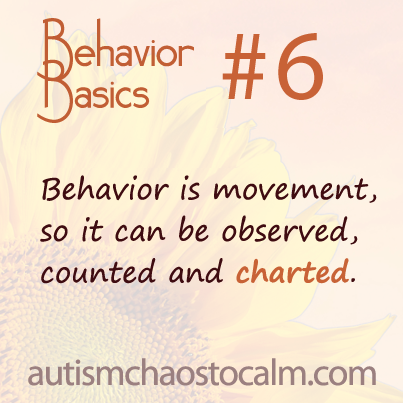 Behavior Basic #5:
Behavior Basic #5:
Behavior is movement, so it can be observed and counted.
Behavior is movement that can be observed (it can be seen or heard), so it can also be counted. A simple way to count a behavior is to count how many times it happens each day. In the example of a child shrieking, you can count how many times during the day the child shrieked. Many parents count behaviors with tally counters; simply attach one to your belt, count every instance of shrieking, and write down the number of instances at the end of the day. This will provide helpful information. You can establish a baseline of how often the behavior occurs. After implementing a behavior plan, the daily counts will tell you whether the plan is succeeding in reducing the behavior.
 Behavior Basic #6:
Behavior Basic #6:
Behavior is movement, so it can be observed, counted and charted.
Behavior is physical movement of the body that can be seen or heard (observed). The movements can be counted. After counting behavior for several days you will have data; for example: on Monday, Johnny shrieked 59 times; on Tuesday, Johnny shrieked 83 times; on Wednesday, Johnny shrieked 76 times. These numbers can be charted or graphed; the line on the chart shows whether the behavior is increasing or decreasing. The Standard Celeration Chart, a Precision Teaching tool, is a particularly effective, scientific tool for charting the rate of change of a behavior.
REMINDER: This concludes the wrap-up of Behavior Basics for the week. Please remember the schedule: On the release date of each module, the Behavior Basics for that module will be compiled into a PDF ebook available from our blog and Facebook page. Click on this link to download the entire series of 42 Behavior Basics for free: http://statictab.com/m7bizwt.